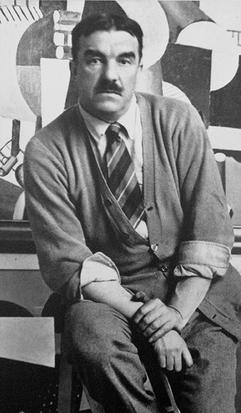
Joseph Fernand Henri Léger was a French painter, sculptor, and filmmaker. In his early works he created a personal form of cubism which he gradually modified into a more figurative, populist style. His boldly simplified treatment of modern subject matter has caused him to be regarded as a forerunner of pop art.

Aubrey Vincent Beardsley was an English illustrator and author. His black ink drawings were influenced by Japanese woodcuts, and depicted the grotesque, the decadent, and the erotic. He was a leading figure in the aesthetic movement which also included Oscar Wilde and James McNeill Whistler. Beardsley's contribution to the development of the Art Nouveau and poster styles was significant despite his early death from tuberculosis. He is one of the important Modern Style figures.
Vincent van Gogh lived during the Impressionist era. With the development of photography, painters and artists turned to conveying the feeling and ideas behind people, places, and things rather than trying to imitate their physical forms. Impressionist artists did this by emphasizing certain hues, using vigorous brushstrokes, and paying attention to highlighting. Vincent van Gogh implemented this ideology to pursue his goal of depicting his own feelings toward and involvement with his subjects. Van Gogh's portraiture focuses on color and brushstrokes to demonstrate their inner qualities and Van Gogh's own relationship with them.
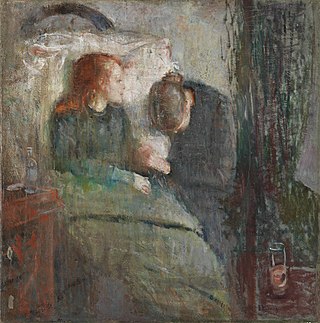
The Sick Child is the title given to a group of six paintings and a number of lithographs, drypoints and etchings completed by the Norwegian artist Edvard Munch between 1885 and 1926. All record a moment before the death of his older sister Johanne Sophie (1862–1877) from tuberculosis at 15. Munch returned to this deeply traumatic event repeatedly in his art over a period of more than 40 years. In the works, Sophie is typically shown on her deathbed accompanied by a dark-haired, grieving woman assumed to be her aunt Karen; the studies often show her in a cropped head shot. In all the painted versions Sophie is sitting in a chair, obviously suffering from pain, propped by a large white pillow, looking towards an ominous curtain likely intended as a symbol of death. She is shown with a haunted expression, clutching hands with a grief-stricken older woman who seems to want to comfort her but whose head is bowed as if she cannot bear to look the younger girl in the eye.

The Weeping Woman is a series of oil on canvas paintings by Pablo Picasso, the last of which was created in late 1937. The paintings depict Dora Maar, Picasso's mistress and muse. The Weeping Woman paintings were produced by Picasso in response to the bombing of Guernica in the Spanish Civil War and are closely associated with the iconography in his painting Guernica. Picasso was intrigued with the subject of the weeping woman, and revisited the theme numerous times that year. The last version, created on 26 October 1937, was the most elaborate of the series, and has been housed in the collection of the Tate Modern in London since 1987. Another Weeping Woman painting created on 18 October 1937 is housed at the National Gallery of Victoria and was involved in a high-profile political art theft.

The Magic Circle is an 1886 oil painting in the Pre-Raphaelite style by John William Waterhouse. Two copies of the painting were produced. The paintings and a study depict a witch or sorceress using a wand to draw a fiery magic circle on the Earth to create a ritual space for her ceremonial magic. As was common in the period, Waterhouse repeated his subject on a smaller scale, probably at the request of a collector.

John Reinhard Weguelin was an English painter and illustrator, active from 1877 to after 1910. He specialized in figurative paintings with lush backgrounds, typically landscapes or garden scenes. Weguelin emulated the neo-classical style of Edward Poynter and Lawrence Alma-Tadema, painting subjects inspired by classical antiquity and mythology. He depicted scenes of everyday life in ancient Greece and Rome, as well as mythological subjects, with an emphasis on pastoral scenes. Weguelin also drew on folklore for inspiration, and painted numerous images of nymphs and mermaids.

The Ugly Duchess is a satirical portrait painted by the Flemish artist Quentin Matsys around 1513.

Mariana is an 1851 oil-on-panel painting by John Everett Millais. The image depicts the solitary Mariana from William Shakespeare's Measure for Measure, as retold in Tennyson's 1830 poem "Mariana". The painting is regarded as an example of Millais's "precision, attention to detail, and stellar ability as a colorist". It has been held by Tate Britain since 1999.

Faust is a series of approximately 100 paintings created between 1976 and 1979 by Nabil Kanso. The paintings depict figural compositions in a sequence of scenes whose subjects are loosely based on Goethe’s 1808 play Faust Part One and Part Two.
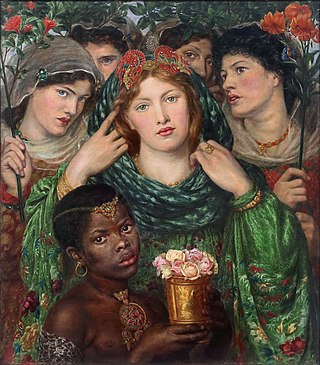
The Beloved is an oil painting on canvas by the English artist Dante Gabriel Rossetti (1828–1882), now in Tate Britain, London. Rossetti signed his initials and the date as "1865-6" on the bottom left of the canvas. It depicts the bride, or "beloved", from the Song of Solomon in the Hebrew Bible as she approaches her bridegroom, with her attendants.

Oi Yoi Yoi is a 1963 oil painting by British painter Roger Hilton. Perhaps Hilton's best-known work, it is a free composition depicting a naked woman. The central figure is abstracted and unpainted canvas, with simple black outlines drawn in charcoal of a featureless face, breasts and pubic triangle, and upraised arms. All four limbs are cut off at the edges of the frame. The white body contrasts with bold segments of background colour in yellow and red, blue and black. The work is inscribed on the back "Oi, yoi, yoi/Hilton/Dec 63".
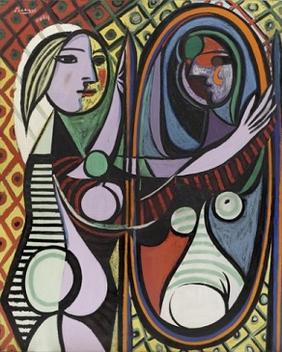
Girl before a Mirror(French: Jeune fille devant un miroir) is an oil on canvas painting by Pablo Picasso, which he created in 1932. The painting is a portrait of Picasso's mistress and muse, Marie-Thérèse Walter, who is depicted standing in front of a mirror looking at her reflection. It is housed in the collection of the Museum of Modern Art in New York City.

The Council Chamber in Amsterdam Town Hall is an oil-on-canvas painting by the Dutch painter Pieter de Hooch. It is held in the Thyssen-Bornemisza Museum, in Madrid.
Elizabeth Murray, born Elizabeth Heaphy, was a British watercolourist. She primarily painted portraits and landscapes of the Canary Islands, where she lived for ten years. She was a member of the Royal Institute of Painters in Water Colours, and was one of the founders of The Society of Female Artists in London in 1857.

Singer with a Glove by Edgar Degas, originally titled Chanteuse de Café, la chanteuse au gant, is an 1878 pastel drawing on canvas 53.2 x 41 cm. Degas was a French artist known for his pastels, paintings, sculptures, prints, and charcoal drawings. This pastel is part of a series of works that have cafe-concert singers as their subject. Degas was a habitué of those places, especially the Cafe des Ambassadeurs, and he uses them as the settings for many of his works.

The Peacock Skirt is an 1893 illustration by Aubrey Beardsley. His original pen and ink drawing was first reproduced as a wood engraving in the first English edition of Oscar Wilde's one-act play Salome in 1894. In later editions it was photo-mechanically reproduced as a lineblock for printing. The original drawing was bequeathed by Grenville Lindall Winthrop to the Fogg Art Museum at Harvard University in 1943.

Lachrymae is a late 19th-century painting by British artist Lord Frederic Leighton. Done in oil on canvas, the work depicts a conceptual figure inspired by classical antiquity. Lachrymae is currently in the collection of the Metropolitan Museum of Art.

Lord Ribblesdale, sometimes known as The Ancestor, is a portrait in oils on canvas by John Singer Sargent of Thomas Lister, 4th Baron Ribblesdale, completed in 1902. The full-length portrait depicts Lord Ribblesdale in his hunting clothes. It measures 258.4 cm × 143.5 cm and has been held by the National Gallery in London since 1916.
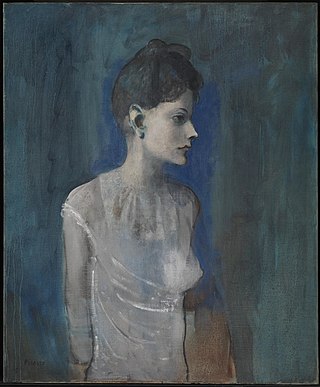
Girl in a Chemise is an oil-on-canvas painting created c. 1905 by Pablo Picasso. It is a portrait of a girl, whom experts believe to be Madeleine, Picasso's girlfriend during this period. Stylistically, the painting belongs to Picasso's Rose Period, although it is predominantly blue in tone. The painting is particularly remarkable for the presence of an earlier portrait of a young boy hidden beneath the surface, which Picasso transformed into the girl by making some subtle changes. The portrait has been housed in the collection of the Tate since 1933.


















